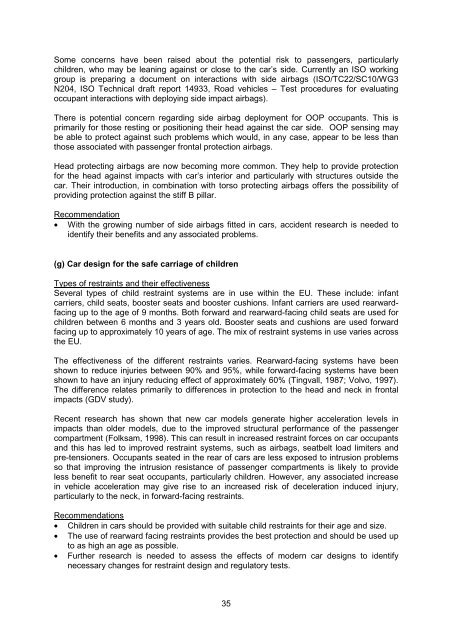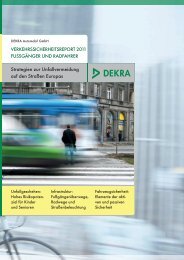PRIORITIES FOR EU MOTOR VEHICLE SAFETY DESIGN
priorities for eu motor vehicle safety design - ETSC
priorities for eu motor vehicle safety design - ETSC
Create successful ePaper yourself
Turn your PDF publications into a flip-book with our unique Google optimized e-Paper software.
Some concerns have been raised about the potential risk to passengers, particularly<br />
children, who may be leaning against or close to the car’s side. Currently an ISO working<br />
group is preparing a document on interactions with side airbags (ISO/TC22/SC10/WG3<br />
N204, ISO Technical draft report 14933, Road vehicles – Test procedures for evaluating<br />
occupant interactions with deploying side impact airbags).<br />
There is potential concern regarding side airbag deployment for OOP occupants. This is<br />
primarily for those resting or positioning their head against the car side. OOP sensing may<br />
be able to protect against such problems which would, in any case, appear to be less than<br />
those associated with passenger frontal protection airbags.<br />
Head protecting airbags are now becoming more common. They help to provide protection<br />
for the head against impacts with car’s interior and particularly with structures outside the<br />
car. Their introduction, in combination with torso protecting airbags offers the possibility of<br />
providing protection against the stiff B pillar.<br />
Recommendation<br />
• With the growing number of side airbags fitted in cars, accident research is needed to<br />
identify their benefits and any associated problems.<br />
(g) Car design for the safe carriage of children<br />
Types of restraints and their effectiveness<br />
Several types of child restraint systems are in use within the <strong>EU</strong>. These include: infant<br />
carriers, child seats, booster seats and booster cushions. Infant carriers are used rearwardfacing<br />
up to the age of 9 months. Both forward and rearward-facing child seats are used for<br />
children between 6 months and 3 years old. Booster seats and cushions are used forward<br />
facing up to approximately 10 years of age. The mix of restraint systems in use varies across<br />
the <strong>EU</strong>.<br />
The effectiveness of the different restraints varies. Rearward-facing systems have been<br />
shown to reduce injuries between 90% and 95%, while forward-facing systems have been<br />
shown to have an injury reducing effect of approximately 60% (Tingvall, 1987; Volvo, 1997).<br />
The difference relates primarily to differences in protection to the head and neck in frontal<br />
impacts (GDV study).<br />
Recent research has shown that new car models generate higher acceleration levels in<br />
impacts than older models, due to the improved structural performance of the passenger<br />
compartment (Folksam, 1998). This can result in increased restraint forces on car occupants<br />
and this has led to improved restraint systems, such as airbags, seatbelt load limiters and<br />
pre-tensioners. Occupants seated in the rear of cars are less exposed to intrusion problems<br />
so that improving the intrusion resistance of passenger compartments is likely to provide<br />
less benefit to rear seat occupants, particularly children. However, any associated increase<br />
in vehicle acceleration may give rise to an increased risk of deceleration induced injury,<br />
particularly to the neck, in forward-facing restraints.<br />
Recommendations<br />
• Children in cars should be provided with suitable child restraints for their age and size.<br />
• The use of rearward facing restraints provides the best protection and should be used up<br />
to as high an age as possible.<br />
• Further research is needed to assess the effects of modern car designs to identify<br />
necessary changes for restraint design and regulatory tests.<br />
35



